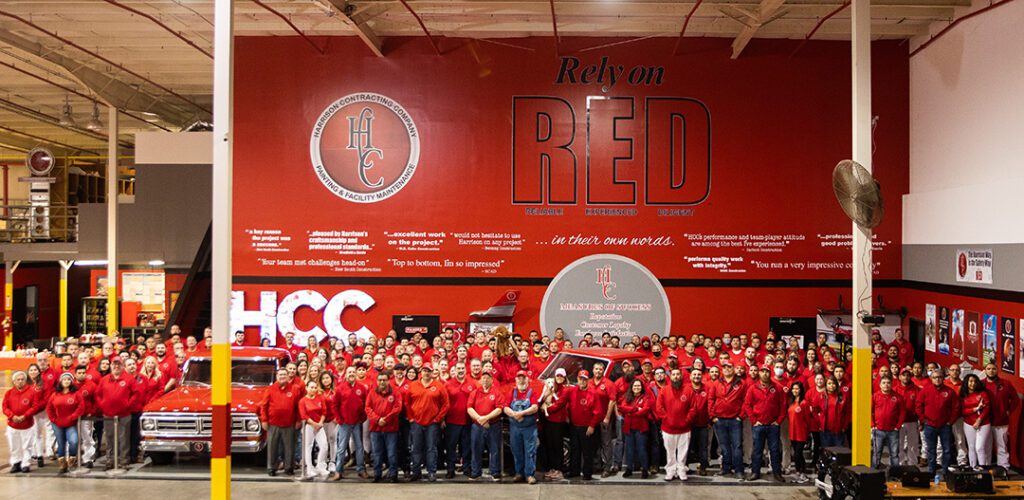Why it’s important — even during challenging times — to keep multi-site painting programs consistent and on track.
There is no question the past few years have presented more challenges than solutions relative to multi-site painting programs. As things have begun moving into a new degree of normalcy, labor and supply chain struggles have been part of the adjustment. Now, as interest rate hikes are implemented to stem the tide of inflation, there are rumblings of “recession.” While not all agree on the specifics, most agree the challenges are real!
So, while there may be some thought given to slowing spend around cycled painting programs, let’s instead focus on the lessons these challenges teach that can keep painting programs moving ahead. As people seek alternatives to isolation and continue getting back out and about, companies are seeing significant increases in customer foot traffic that drives the need to refresh and maintain their facilities. Additionally, the online boom has raised the bar for brick-and-mortar locations to create and sustain more meaningful and valuable customer experiences. Letting go of ongoing maintenance may seem like a budgetary savings, but keeping cycle programs charging forward is almost necessity. “How,” might you ask? Well, here are a few key points to help address that question.
CONSISTENCY DRIVES CURB APPEAL
Keeping your cycle programs running is paramount to favorable customer experience. It’s more than simply aesthetics, although that is primary; it also encompasses protection and durability of your facilities. The alternative approach of deferring maintenance for a few years may seem like a good option to extend capital spending, but in the long run overall facility appearance suffers and detracts from a customer’s positive experience with your brand.
Think about pulling into your own neighborhood and driving by the “yard of the month” house. (Personally, I try to avoid that house on my route just to prevent the feeling of inadequacy around my own lawncare approach.) But all kidding aside, we all want the “yard of the month” look for our own home. We might get there once or twice a season, sure, with extra time, money and effort, but somehow it still comes just short of the “yard of the month” club. To get there, it takes consistent effort and investment. This ensures that key improvements and maintenance are done in bitesized pieces, which also generates a higher quality result with greater efficiency.
Likewise, your service provider stands a much better chance at supporting your needs and delivering on that quality if your programs don’t start and stop. If you paint your envelope today and wait 6-7 years before touching it again, there will likely be more “weed eating” (keeping the above metaphor alive). This can also cause drain on both labor and administrative manpower as your provider will ramp up and down with your cycles. While the ramping down can happen relatively quickly, the ramp-up time is more difficult to turn on. Working with your provider to build a consistent program will ensure they can keep the manpower operating at effective levels — which, in turn, helps maintain the curb appeal you desire.
CONSULTATION BEFORE IMPLEMENTATION
This may seem like a “captain obvious” header, but the need to get things done can sometimes outweigh getting things done correctly. Direct engagement with your provider early in your cycle program process can make all the difference in effective operationalization. Capitalize on the experience of your provider and encourage them to be involved in every aspect of your desired outcome. This includes scope of work, logistical strategy, specification considerations and labor needs. Open dialogue as early as possible will drive collaboration for a better, more mutually beneficial outcome.
A collaborative approach also encourages service providers to conduct a thorough situational appraisal. This is where the rubber meets the road. Best intentions and desired outcomes need physical engagement from contractors who can assess how each of the components of the painting program work together and what may be missing that could have detrimental impact. There are certainly some areas that can be considered “common” across multiple sites but ensuring that you’ve got a scope of work that aligns with desired outcome will help create a sound RFP with the highest likelihood of success.
MANAGING SUPPLY CHAIN & ECONOMIC HURDLES
There has been no shortage of issues to work through these past years. Some of the ripple effects of COVID-related shutdowns created significant supply chain issues over the past 12-20 months. The issue here has been not simply ‘getting through it,’ but rather working through it. That may appear to be a subtle difference, but the latter stems from experiential wisdom. Wisdom can be generally defined as “putting into practice what you know to be true based on actual experience.” I see this as more of a practical attitude rather than a literal application. I think it’s more about “let’s figure this out” rather than “let’s regroup” or “let’s find a way out.” The former says we’re still here and we are going to find the way to get it done. That must be born from a culture of never really being satisfied with “status quo.” Working with providers that have this diligent spirit helps navigate even the most unexpected hurdles.
For years I’ve carried with me a quote that I believe has a lot of truth. I’m not sure of the origin of the quote, but there have been many iterations: “Luck favors those who are most prepared.” When you think about running a painting program across multiple sites, whether hundreds or thousands, you really don’t want to count on luck as a part of your strategy. Likewise, your painting program provider should have program experience and wisdom. That will minimize the uh-oh moments and ensure that your program can be managed through the waves. That doesn’t mean they’ve been through exactly every situation that you’ll face, it just means there is higher likelihood that they’ll strive to figure it out based on relative experience.
At the end of the day, partnership with your provider makes or breaks the success of your planned painting programs. The key is moving forward versus starting and stopping. Keeping painting programs moving consistently forward drives long term engagement, and yes, investment, from your provider. They become “connected” and, as such, they want success the same as you. Partnership also drives performance on many levels. Running a large multi-site FM program demands that you utilize all your resources for the most efficient outcome. That includes a provider who isn’t agreeing on every topic, but rather a provider that speaks up to point out challenges and issues. This creates opportunities for better quality.

By Sean Gillespie
Director | Strategic Alliances, Harrison Contracting Company, Inc.
Sean Gillespie is director | strategic alliances for Harrison Contracting Company, Inc. With more than 35 years of experience in the paint industry, Gillespie has worked in several sales and marketing leadership roles; he joined Harrison in June 2018. Harrison has been working in the retail segment helping execute multi-site repaint programs since 1995. Its reliable, experienced and diligent (RED) culture is expressed in everything from its work approach to its company color. Harrison can help consult and/or operationalize your cycle or reimage painting program.
